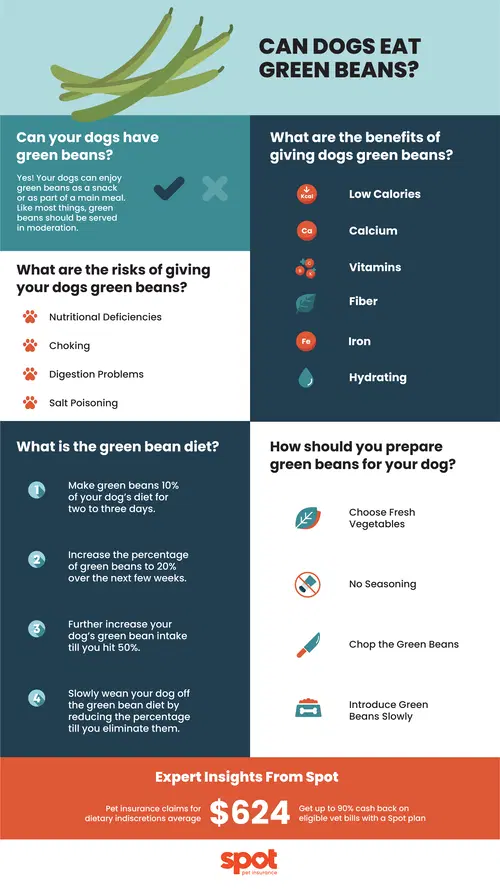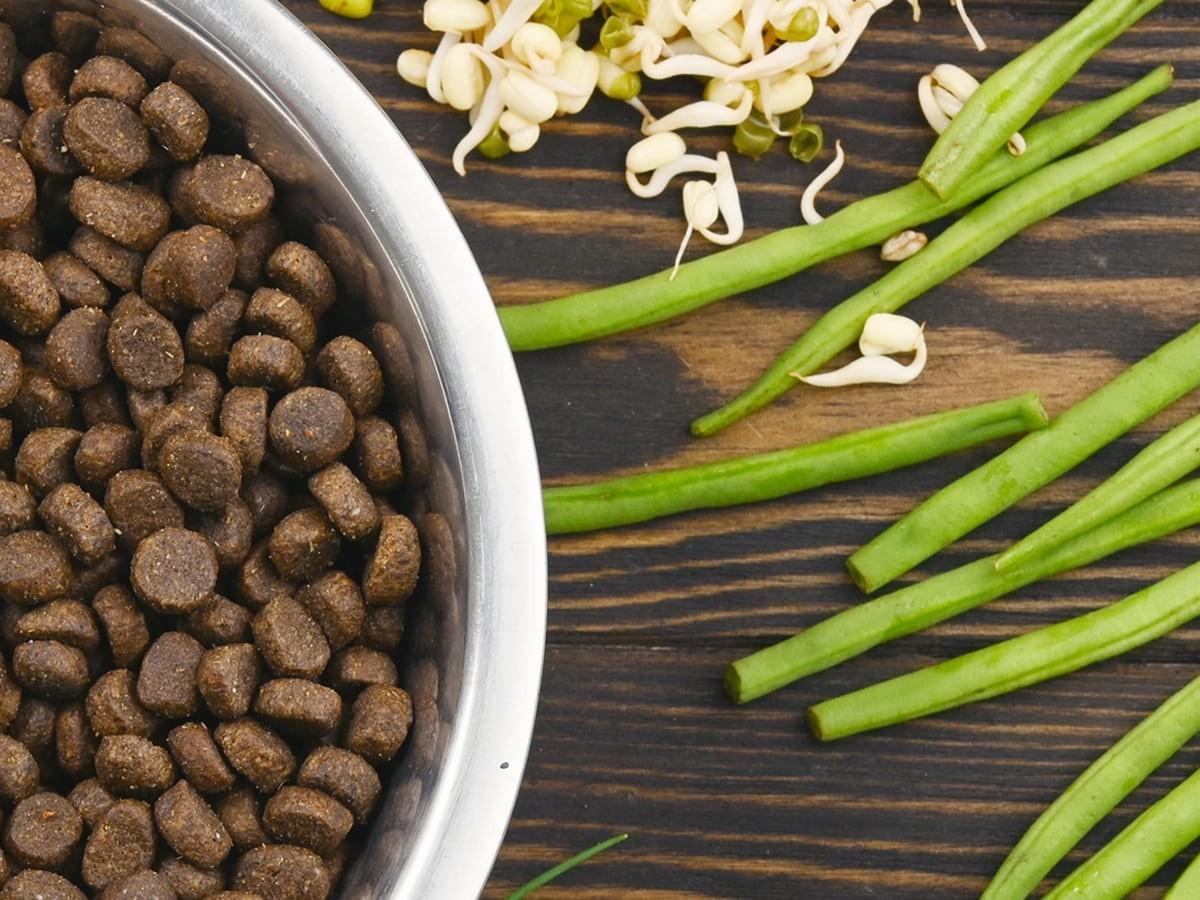Lately, the green bean diet for dogs has risen in popularity. Essentially, people are replacing 10% of their pup’s regular dog food with green beans — supposedly to help with weight loss.1
So many pet owners are now wondering about this food choice. Is it safe? Is it healthy? Do green beans offer the same nutrients to dogs as to humans? If so, how much should you feed your pet?
Fear not! Spot Pet Insurance will give you all the details you need to decide whether or not you should feed your dog green beans.
Can Your Dogs Have Green Beans?
Generally, each dog may react differently to various foods. While some dogs relish green beans, others might refuse to touch them at all. But are green beans safe?
Yes! Your dogs can enjoy green beans as a snack or as part of a main meal.
Like most things, green beans should be served in moderation. Luckily, dogs can enjoy both raw and cooked green beans, which means there are countless creative ways of adding them to your dog’s diet.1

Are Green Beans Good for Dogs?
Green beans are generally safe for dogs since they don’t include toxins. However, just because they’re safe doesn’t mean that you should fill your dog’s bowl with green beans.
Eating too many green beans could give your dog some unpleasant symptoms.2 Furthermore, dogs don’t need too many vegetables in their diet since veggies aren’t their primary energy source.
A dog’s body needs lots of healthy fat and proteins. Giving your dog too many vegetables without proteins and healthy fat can negatively affect their nutrition. So, if you’re adding green beans to your dog’s diet, make sure to include enough animal proteins so that they get complete nourishment.
What Are The Benefits of Giving Dogs Green Beans?
Green beans can offer your dog (and you!) lots of health benefits. They contain lots of fiber and antioxidants, and they’re also full of essential vitamins and minerals.2
Here are some ways that green beans may help your dog stay healthy.
Low calories
Sometimes your vet may ask you to put your dog on a low-calorie diet. Green beans don’t contain lots of calories, so they can fit such diets perfectly.
Green beans are nutrient-dense vegetables. That means your dog can enjoy their numerous benefits from just a moderate amount — no need to overload their dish!
Calcium
Every dog should have strong bones, and green beans are full of calcium they need for optimal bone health.1 Calcium is also important for optimal heart health, so it’s important to make sure it’s a regular part of your pup’s diet.
Vitamins
Like people, dogs need several vitamins to help keep them healthy. Luckily, there are several key vitamins that your dog can get from green beans.1
Vitamin A helps protect your dog’s eyesight and immunity.
Vitamin C speeds up wound healing, keeps tissues healthy, and strengthens immunity.
Vitamin B provides coenzymes to help break down food for energy.
Vitamin K helps your dog’s blood clot properly if they get a bruise or cut.
Iron
Iron is a crucial mineral that helps carry oxygen around your dog’s body. Fortunately, green beans contain iron that helps your dog produce healthy red blood cells.
Fiber
It’s always good to keep your dog’s gut healthy by giving them some fiber, which can come in the form of green beans. This may reduce your dog’s chances of having tummy trouble.
Fiber helps your dogs have regular bowel movements. It also helps their stomachs feel full, meaning they’re less inclined to overeat. That’s why many pet owners add this veggie to their dog’s diet — they’re trying to help their pup maintain a healthy weight or even lose a few pounds.1
Water
Green beans have a high water content, so they’re a hydrating vegetable. On a hot day, green beans can be a great snack to help keep your dog hydrated.
What Are The Risks of Giving Your Dogs Green Beans?
Green beans can be great for your dog, but that doesn’t mean you should overdo it. You’ll want to consider a few risks before making any dietary changes.
Nutritional Deficiencies
Green beans can help your dog stay full for extended periods. However, dogs also require nutrients from meat and fat. If your dog is eating too many green beans, they may not want to eat their regular food and miss out on getting proper nutrition.
To help keep things healthy, remember that this veggie should be a snack or a supplement to a meal, not the main course.
Choking
While bigger dogs may be able to scarf down whole beans, small dogs may be at risk of choking. A great way to help reduce your dog’s choking risk is by cutting up green beans before serving them.
Digestion Problems
Eating excess green beans may give your dog gut-related symptoms.2 If your dog shows any of these signs, consider reducing how many green beans they’re getting:
Diarrhea
Gas
Of course, any new food introduced into a dog’s diet can cause tummy problems. It’s always best to introduce new foods slowly and steadily rather than all at once.
Salt Poisoning
When choosing vegetables for your dogs, it’s usually better to go fresh. Canned green beans contain lots of salt, which can cause several health problems and affect a dog’s balance of electrolytes.3
Expert Insights From Spot
While sharing our favorite foods with our pets can be tempting, it's important to remember that not all human foods are safe for dogs. Spot's internal data shows that pet insurance claims for dietary indiscretions average $642*, highlighting the importance of caution and research before sharing snacks with your pet.
What Is The Green Bean Diet?
The green bean diet is a low-calorie diet for dogs where dog owners substitute 10% of their dog's diet for green beans. People trying to reduce their dog’s calorie intake may slowly increase how many green beans their dog eats daily till they achieve visible results.1 Here’s a brief outline of how the green bean diet typically goes:
Make green beans 10% of your dog’s diet for two to three days.
Increase the percentage of green beans to 20% over the next few weeks.
Further increase your dog’s green bean intake till you hit 50%.
Slowly wean your dog off the green bean diet by reducing the percentage till you eliminate them completely.
The green bean diet may be effective, but there are some downsides. Dogs need enough animal protein in their meals to stay healthy, and when you change your dog’s diet so drastically, there’s a risk of malnutrition. In particular, the third step above can cause problems for your dog.2
Your dog’s energy needs will also determine what type of food they need. Less active breeds like the shar-pei will usually require a different diet than more physically active breeds like border collies.
Before trying the green bean diet for your dog, talk to your vet to see if it’s the right choice. Your vet can also help you decide the best way to adopt the green bean diet, so your pup doesn’t suffer from nutritional deficiencies.
How Should You Prepare Green Beans for Your Dog?
Luckily, there’s really no wrong answer here! As long as you’re using fresh veggies, your dogs can enjoy green beans raw or cooked, in their main meal, or as a hydrating snack.
That said, here are some tips you should remember when preparing green beans for your dog:
Choose fresh vegetables
Buy fresh and healthy-looking green beans for your dogs. Stay away from canned veggies because they contain too much salt. Organic green beans are best since they’re free from toxic fertilizer and pesticide residues.
No seasoning
Hold off on the seasoning when you’re cooking green beans for your dogs. Too much salt can affect your dog’s health, and there’s no need for spices. Some common ingredients that make food tastier for humans — for instance, onions and garlic — can be toxic for dogs.4
Chop the green beans
Whether you’re giving your dog cooked or raw green beans, chop them up first. The smaller pieces are easier for your dog to pick up, especially if they’re a puppy, and it can help reduce the risk of choking.
Introduce green beans slowly
As we mentioned above, it’s crucial to slowly introduce your dog to green beans. Eating too many green beans too quickly can induce adverse effects like vomiting and diarrhea. Start by making green beans less than 10% of your dog’s diet and work your way up.
How Many Green Beans Should Your Dog Eat?
Your dog needs most of their food to come from meat and meat products, and vegetables shouldn’t make up more than 25% of your dog’s meals. In fact, eating too many vegetables can deprive your dog of much-needed nutrients.5
If you’re creating dishes that require multiple vegetables for your dog, try to stay within the 25% limit. Beyond that, you’ll need to speak to your vet. They’ll help you identify your dog’s unique energy and nutrition needs and assist you in creating the best meal plan for your dog’s health.
Conclusion
For dog parents, keeping their pets happy and healthy is crucial. Adding healthy vegetables to your dog’s diet can be a great way to aid in this mission.
Green beans, in particular, can be a great veggie to go with. They can give your dog vital minerals and vitamins, and they also contain lots of water for hydration and fiber for gut health.
Nonetheless, don’t give your dog green beans excessively. They may miss out on important nutrition if they don’t eat enough meat products. Also, when preparing green beans for your pup, make sure to choose fresh organic ones and avoid adding spices or salt.
Although you’ll want to speak with your vet to confirm how many green beans is too many for your dog, you should now have a better idea of how and why to serve your dog this nutritious veggie.
Have other questions about your furry friend’s diet and nutrition needs? Spot Pet Insurance can help you make good decisions for your dog with its wealth of useful pet information.

Creative manager by day, pet enthusiast all the time! After 19 years with my dog (hopefully he wins the award for oldest pet in the world), I enjoy spending my days brainstorming tail-wagging content, and sniffing out the latest trends in the pet world.
*Jan 2019 to Aug 2024 administrator claims data.
Burke, Anna. “Can Dogs Have Green Beans?” American Kennel Club, 25 Aug. 2022, www.akc.org/expert-advice/nutrition/can-dogs-have-green-beans.
“Can Dogs Eat Green Beans? Here’s Everything You Need to Know.” Pawlicy Advisor, n.d., www.pawlicy.com/blog/can-dogs-eat-green-beans.
Johnson, Larry. “Salt Toxicosis in Animals - Salt Toxicosis in Animals.” MSD Veterinary Manual, May 2022, www.msdvetmanual.com/toxicology/salt-toxicity/overview-of-salt-toxicity.
Schenker, Michelle. “Foods Dogs Can’t Eat: 46 Dangerous Human Foods.” Canine Journal, 16 July 2024, www.caninejournal.com/foods-not-to-feed-dog.
Clay, Cholee. “Vegetables That Are Good for Dogs - Pethelpful.” Pet Helpful, 22 Mar. 2023, pethelpful.com/dogs/Vegetables-That-Are-Good-For-Dogs.
The information presented in this article is for educational and informational purposes only and does not constitute or substitute for the advice of your veterinarian.












